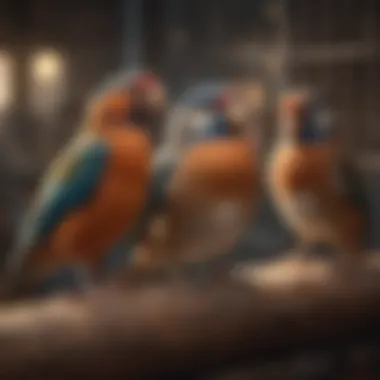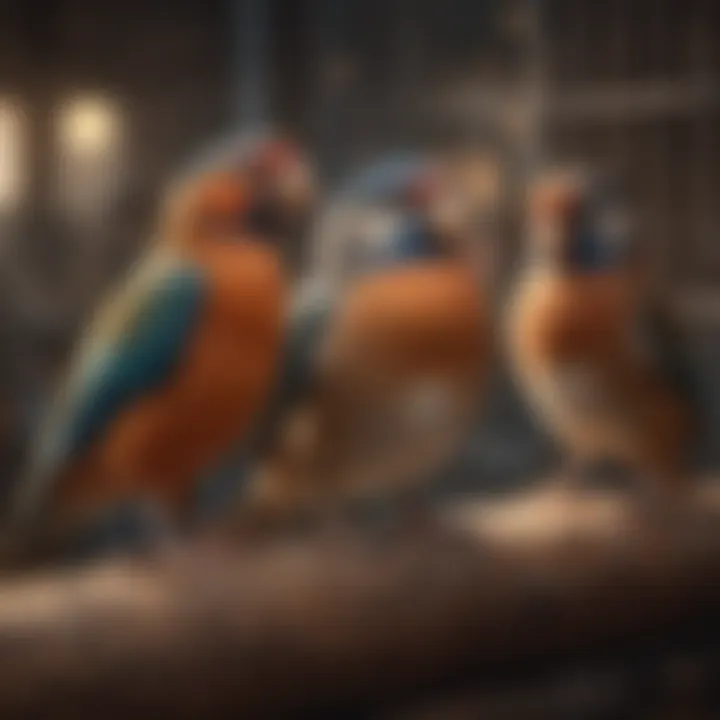The Importance of Long Bird Cages for Pet Birds


Intro
Pet bird ownership is not just a hobby; it’s a commitment to enhancing the lives of our feathered companions. One major component of this commitment is the type of cage we choose for them. Long bird cages have gained attention as an essential element in providing a better living environment. This might raise a few eyebrows, but when you dig deep, you realize that the size and shape of a cage can significantly affect a bird’s behavior and overall well-being.
Unlike traditional cages, which might be compact and limiting, long bird cages offer an expansive playground for our avian friends. The design facilitates more natural movement, giving birds room not only to fly but also to explore and engage in activity that mimics their behaviors in the wild. This distinction becomes vital, especially when considering the elaborate nesting and social habits that many species possess.
In an effort to dissect the nuances, this article will break down various aspects of avian care through the lens of long bird cages, ranging from essential care tips to behavioral insights, nutrition, and enrichment activities. The goal here is to provide seasoned bird owners and newcomers alike with substantial information to optimize their pet birds' habitat and enhance their quality of life.
Understanding the Necessity of Long Bird Cages
In the realm of avian care, the type of cage chosen has a profound impact on the overall health and happiness of pet birds. Long bird cages have emerged as a significant topic in this field, primarily because they cater to the instinctual behaviors and needs of various bird species. Aiming for space that allows movement and activities is crucial for anyone who wishes to keep their avian companions thriving. Here, we delve into the myriad reasons long bird cages are not just a luxury, but a necessity.
Historical Context of Bird Cages
Bird cages have been a part of human history for centuries. They’ve transitioned from simple structures crafted from natural materials to intricate designs made of metals and plastics. Historically, cages were often small, intended to merely keep the birds contained, rather than catering to their needs. This approach stemmed from a lack of understanding about birds’ social and physical requirements. Only in more recent times, driven by studies on animal behavior, has the focus shifted toward providing more spacious, enriched environments reflecting birds' natural habitats.
Shifts in Bird Keeping Practices
As society evolved, so did the perception of bird keeping. The mid-20th century saw a rise in awareness around animal welfare, sparking conversations on how to provide better living conditions for pets. In the past, it was common to see birds confined to diminutive cages that did not allow for even basic flapping of wings. Nowadays, a larger number of bird owners recognize that birds require ample room to move, explore, and interact with their surroundings. This shift emphasizes the importance of long bird cages, which support not just flight but also crucial social behaviors among birds.
Current Trends in Avian Habitat Design
Modern trends in avian habitat design reflect a deeper understanding of birds and their unique needs. Long bird cages are designed to simulate aspects of the outdoors—featuring various perches, toys, and even plants. This forward-thinking approach enables pet owners to create dynamic environments where birds can engage in natural behaviors, such as climbing and flying. Increasingly, manufacturers are also incorporating materials that are not only durable but also safe, making long cages the gold standard in bird care today.
"A spacious cage is not merely about containment; it's about fostering a joyful and engaging lifestyle for your feathered friend."
The significance of long bird cages extends beyond just aesthetics. They represent a commitment to enhancing the quality of life for pet birds, reflecting an evolution in how we perceive and care for these creatures. The rich history, shifts in practices, and current design trends converge to illustrate why understanding the necessity of long bird cages is paramount for anyone considering avian companionship.
The Role of Space in Bird Behavior
When we talk about bird behavior, one can't underestimate the influence of spatial dynamics. For our feathered friends, space isn’t just a luxury; it’s a fundamental aspect of their well-being. Long bird cages provide that necessary room for movement, social interaction, and exercise. As we dig into the specifics of how space impacts the behavior of birds, it’s clear that thoughtful cage design can substantially enhance the lives of our avian companions.
Understanding Avian Movement
Birds in the wild spend a large chunk of their lives in search of food, mates, and suitable habitats. In captivity, especially in confined spaces, they can’t exhibit their natural movement patterns, which can lead to boredom and distress. Long cages allow for extended flight paths, enabling birds to soar and glide, mimicking their natural instincts.
The physics of avian movement tells us that the ability to stretch and flap their wings in a larger space isn’t just enjoyable—it's essential for their physical health. Here are a few benefits of ample space:
- Exercise: A long cage enables birds to exercise effectively, reducing the risk of obesity.
- Exploration: They can explore various cage levels and corners, promoting mental stimulation.
- Wing Flapping: Sufficient space encourages normal wing flapping, which keeps their muscles toned.
Social Needs of Different Bird Species
Different species of birds have varying social needs. Take parrots, for instance—they thrive in social settings and often require interaction not only with humans but also other birds. Long cages can be designed to accommodate multiple birds or simply provide a more enriched environment to fulfill their social needs.
The layout of a long cage can vary to support the social structure of its inhabitants. For instance:
- Perches at Different Levels: This allows birds to establish hierarchy in a non-confrontational way.
- Shared Spaces: Creating areas where birds can interact without feeling cornered or threatened—important for species that engage in more group behaviors.
Understanding the social dynamics among bird species influences how we arrange their living spaces and the accessories we provide, such as toys and feeding stations.
Reflection of Natural Habitats
Birds are, in a sense, product of their environment. Long cages should aspire to mirror their natural settings, leading to happier and healthier birds. By reflecting natural habitats, we provide psychological benefits that go beyond mere physical comfort.
Consider how we can implement this:
- Vertical Space: Many birds live in trees and need vertical room to feel secure. Long cages as opposed to tall cages support this natural tree-like landscape.
- Variety in Enrichment Materials: Incorporating natural materials for perches and nests can help recreate an inviting atmosphere.
- Natural Light: Positioning the cage near a window can replicate the natural light conditions birds experience in the wild, promoting a sense of normalcy.
"The more we can recreate their natural environments, the more likely we are to witness positive behavioral traits in our birds."
Design Features of Long Bird Cages
When it comes to ensuring the well-being of pet birds, the design features of their cages can't be overlooked. Long bird cages, in particular, provide a framework that caters to an avian's natural instincts and behavior, making them an essential component in avian care. This section outlines the critical aspects of cage design, including materials, dimensions, and accessibility, while elucidating their importance in creating a nurturing environment for our feathered friends.
Materials and Construction


The choice of materials used in long bird cages plays a significant role in both safety and functionality. Common materials include stainless steel, powder-coated metal, and durable plastics. Stainless steel is often deemed the gold standard due to its resistance to corrosion and ease of cleaning. It not only stands up to the wear and tear that comes with an active bird, but it also prevents the leaching of harmful substances into the environment.
While choosing materials, one should also consider the construction techniques. A robust design—rigid joints and bars that do not bend easily—ensures safety and longevity. Furthermore, cages should have non-toxic finishes and easy-to-clean surfaces to promote hygiene. After all, cleanliness is a big player when it comes to preventing diseases in our avian companions.
Dimensions and Layout Considerations
Dimensions of long bird cages are not just about fitting the space in your home. A well-structured layout that prioritizes height and length can make a noticeable difference in a bird's happiness and health. An ideal cage allows birds to extend their wings fully—think about flight as an essential part of daily activity. Ideally, it should measure at least three or four times the wingspan of the bird, providing ample vertical and horizontal space for movement.
Designing for different birds brings its own set of challenges, as preferences can fluctuate widely among species. Larger breeds like macaws or cockatoos require more cubic space, while smaller breeds might benefit from expansive horizontal surfaces that allow them to hop and glide without restrictions.
Outside of size, the layout considerations are crucial. Placing perches at varying heights fosters natural behaviors and helps in exercising their muscles. Don't forget about the placement of food and water dishes, which should ideally be at multiple levels in case of social hierarchies, ensuring every bird has access without conflict.
Accessibility and Maintenance
Accessibility is key to maintaining both the cage and the birds' well-being. Cages should be designed with wide doors that open fully, allowing for easy access when it comes time for cleaning or interacting with your pet. The interiors should be arranged in a way that allows for cleaning with minimal fuss. Bird owners often overlook this, but it's crucial—dirty cages can lead to health problems down the line.
Maintenance should also extend to the cage construction. Smooth edges, secure locks, and non-removable parts are all vital to ensure not just ease of access but also the safety of the birds.
Caring for the habitat should not feel like a daunting task. Investing time in thoughtful design and maintenance can enhance both the longevity of the cage and the quality of life of your birds. By ensuring that materials are durable, dimensions are thoughtfully planned, and access points are clear, you create an environment where birds thrive—not simply survive.
Benefits of Long Bird Cages
The advantages of long bird cages stretch much further than merely providing a home for your avian friends. Choosing the right cage is pivotal for fostering not only a comfortable living space but also a thriving environment that caters to the unique needs of different bird species. Long cages, in particular, have numerous benefits that can ultimately enhance the well-being of your pet birds. Understanding these advantages allows bird owners to make informed choices that can lead to happier and healthier birds.
Enhanced Flight Opportunities
One of the standout benefits of long bird cages is the expanded flying space they provide. Unlike traditional square or cubical designs, long cages allow birds to engage in more natural flight patterns, which are crucial for their physical well-being. Birds, like the agile budgerigar or the vibrant canary, thrive in environments where they can spread their wings, literally and figuratively.
The layout of a long cage fosters flight length rather than height, enabling birds to exercise their wings over longer distances. With such a setup, you might notice your feathered companions darting back and forth, engaging in essential cardiovascular exercise that can stave off obesity and promote overall health.
Additionally, this design can also reduce stress-induced behaviors, as the birds are less likely to feel confined. By allowing ample flight opportunities, you not only honor their natural instincts but also elevate their quality of life significantly.
Improved Activity Levels and Health
Birds are natural athletes, bustling with energy and curiosity. Long cages promote high activity levels by presenting ample space to move around and explore. With more room to perch, play, and swing, your feathery pals are more likely to engage in exploration and exercise, leading to better physical health.
Research suggests that increased activity positively influences vital factors like metabolism and muscle tone. Birds kept in spacious environments often demonstrate improved agility and endurance. Take, for instance, larger parrots such as African Greys—these intelligent creatures require more stimulation to stay engaged. In a long cage, they can navigate through a variety of perches and toys, contributing to mental stimulation as well as physical exercise.
Moreover, maintaining an active lifestyle within a spacious cage can also trigger the release of endorphins, allowing birds to feel happier and more content. This is crucial for their emotional and psychological states and aligns with the belief that a healthy bird is a happy bird.
Stress Reduction and Behavioral Improvement
In the realm of avian care, stress can lead to unwanted behaviors that may cause concern for any bird owner. Issues like feather plucking, excessive vocalizations, or aggression often arise from a lack of space and stimulation in traditional cages. Long cages serve as a remedy by reducing stressors associated with confinement.
With more room to roam, birds can easily find personal space, which is important for their mental health. They can choose to perch, swing, or explore on their own terms. Such autonomy is vital in fostering a relaxed atmosphere that encourages well-being.
"Creating an environment where birds can stretch their wings and feel secure is central to their happiness."
Furthermore, as the birds feel less cramped, there’s a notable decrease in territorial disputes, particularly in multi-bird households. Longer cages help minimize friction between feathered friends, promoting harmony and decreasing the chance of skirmishes. This careful attention to their social needs reflects a deeper understanding of bird behavior, transforming the everyday living area into a sanctuary conducive to both physical activity and emotional stability.
In summary, opting for long bird cages offers multifaceted benefits that directly influence your pet bird's life quality. Enhanced flight opportunities, improved health through higher activity levels, and significant stress reduction through better behavioral context are all compelling reasons to embrace longer designs. When you invest in the right cage setup, you are really making an investment in your bird's lifelong happiness.
Choosing the Right Long Cage
Choosing the right long cage can feel like a daunting task for many bird owners, but it shouldn’t be brushed aside. The right cage serves as a sanctuary for our feathered friends, influencing not only their physical well-being but also their mental state. It's essential to consider various elements that speak to your bird’s needs, ensuring that your choice aligns well with their unique characteristics.
Assessing Your Bird's Species and Size Needs
When picking a cage, the first stop should be your bird's species and size. Larger birds like macaws or cockatoos require cages with generous dimensions that allow for free movement and stretching of wings. Parakeets or finches, while smaller, still need a cage that promotes their natural behaviors, like flying and climbing. To get the right fit:
- Consult Species Guides: Different species have unique requirements. A conure needs a different setup compared to a lovebird.
- Measure Your Bird: Familiarize yourself with your bird’s wingspan and size. The general rule of thumb is to allow at least two wingspans in width.
By aligning the cage size with the species and individual bird needs, owners can create a space that not only accommodates but enhances the bird's lifestyle.
Integrating Cage Accessories


Long cages not only need to be spacious but also functional. Accessories are important for providing exercise and stimulation. Here, the options are plenty, but let’s keep it straightforward:
- Perches in Different Diameters: Birds need perches to rest. Use various sizes to promote foot health and mimic natural environments.
- Toys for Engagement: Incorporate toys that challenge their minds. Chew toys or foraging wheels can keep birds busy and mentally engaged.
- Feeders and Water Stations: Positioning these essentials strategically in a long cage allows for ease of use while preventing mess.
Including the right accessories promotes both physical activity and mental health for birds, turning a plain cage into a playful haven.
Balancing Aesthetics and Functionality
While it might be easy to get sidetracked by how pretty a cage can look, it’s vital to ensure that aesthetics do not eclipse functionality. A well-designed long cage should harmonize with your home while serving its primary function.
- Material Matters: Opt for sturdy, non-toxic materials that are safe for birds. After all, durability and safety hold the top spot.
- Cleanability: A cage that is easy to clean is a must. Look for designs with removable trays or no sharp corners.
- Environment Matching: Try to choose colors and styles that fit your home decor without taking away the purpose it serves.
Finding a balance between these aspects doesn’t just enhance your home’s beauty; it also contributes to the overall health and enjoyment of your pet bird.
A thoughtfully selected cage acts as an integral part of a bird’s world, creating a space where it can thrive both physically and mentally.
Long Cages in Comparison to Traditional Designs
When it comes to avian care, the discussion around bird cages often centers on their dimensions and design. Long cages have emerged as a more favorable option compared to traditional, more compact types. Understanding this importance requires a closer look at how these cages benefit both birds and their caretakers through enhanced living conditions and well-being. This section will delve into the reasons why opting for longer cages can be a game changer in bird keeping.
Advantages of Extended Length
Long bird cages offer a variety of advantages that highly contribute to the overall health and happiness of pet birds:
- Increased Space for Flight and Movement: Unlike standard cages, long cages enable birds to fly horizontally, which is crucial for their physical health. Flight is a natural behavior, and birds thrive when they are able to engage in it. Species like parakeets and cockatiels, for instance, require longer distances to flutter and exercise their wings effectively.
- Reduction in Stress and Aggression: Given more room, birds have a better chance to create their own territories. This helps minimize conflicts among flock members. Birds experiencing stress may exhibit feather plucking or aggressive behavior, which can severely impact their mental well-being. In a long cage, they can establish their areas and engage in natural, less confrontational behaviors.
- Multiple Perches and Enrichment Options: Long cages allow for the inclusion of various perches of different heights and textures. This variety encourages exploring and climbing, activities that keep birds engaged. It’s also easier to position toys and enrichment items, which aids in mental stimulation.
- Easier Observation: For bird owners and caregivers, a longer cage gives a better perspective on their pet’s behavior patterns. Longer dimensions provide distinct zones within the cage, making it easier to spot any signs of health issues that could easily go unnoticed in smaller, crowded spaces.
"Birds kept in spacious environments not only display positive behavioral outcomes but also develop a stronger bond with their caretakers thanks to less stress and more engagement."
Potential Disadvantages and Limitations
While long cages bring numerous benefits, it’s also essential to acknowledge some potential downsides:
- Space Constraints in Homes: Not all living environments can accommodate long cages. Apartment dwellers or those with limited space may find longer cages can become a logistical challenge. This consideration can deter some owners from making the necessary investment in a long cage, despite its advantages.
- Cost Implications: Longer cages typically come at a higher price point. The investment might be a stumbling block for some pet owners, particularly without a clear understanding of how vital a larger habitat is for their birds.
- Maintenance and Cleaning Challenges: While it’s generally easier to monitor bird activity in larger spaces, keeping a long cage clean can be more demanding. The increased area means more corners and spaces where debris and droppings can accumulate, requiring a more diligent cleaning routine to maintain hygiene.
Ultimately, when comparing long cages to traditional designs, the benefits largely outweigh the disadvantages, especially considering the psychological and physiological needs of pet birds. Ensuring your bird has a suitable living environment can translate to a happier pet and, as a result, a more fulfilling relationship between the bird and its owner.
Care and Maintenance of Long Bird Cages
When it comes to avian care, maintaining a clean and safe environment in long bird cages is crucial to ensure the well-being of our feathered friends. A well-kept cage not only provides a healthy habitat but also supports the physical and psychological needs of birds, ultimately enhancing their quality of life. With the unique values offered by long cages, it's essential to focus on effective cleaning protocols, regular inspections, and providing necessary enrichment for our birds.
Cleaning Protocols and Best Practices
Maintaining cleanliness within your bird's habitat is more than just a routine task; it's a fundamental aspect of health. Here are some key points to consider regarding cleaning protocols:
- Frequency: Regular and thorough cleaning should be scheduled. Spot cleaning daily can help manage droppings and leftover food, while a deeper clean should happen weekly.
- Materials: Use safe, non-toxic cleaning products. Vinegar mixed with water is a natural cleaner, effective against bacteria. Avoid bleach or any harsh chemicals that could harm your birds.
- Tools: Have a set of supplies designated solely for your bird's cage – sponges, brushes, and cloths should be easy to clean and store.
- Disassemble: When performing a deep clean, remove all accessories such as perches, toys, and food bowls to clean every nook and cranny. This helps prevent build-up of bacteria in hidden spots.
In essence, a clean cage translates into a healthy bird, reducing the risk of disease and promoting a lively environment.
Regular Inspections for Safety
Regularly inspecting long bird cages is as critical as cleanig them. Safety checks should not be overlooked, both for the bird's protection and the longevity of the cage itself. Here are essential aspects to consider:
- Structural Integrity: Check for any weakened joins, rust spots on metal cages, or any loose parts that may pose a risk to birds.
- Perches and Accessories: Ensure that perches are intact and secure. Swapping them out occasionally keeps the environment fresh. Additionally, remove any toys or accessories showing signs of wear.
- Escape Routes: Ensure there are no gaps that are wide enough for birds to wriggle through. This is particularly crucial for smaller breeds.
Understanding that a quick checklist can save a bird's life makes inspections not just a chore, but a wise necessity.
Ensuring Enrichment and Stimulus
Last but definitely not least, long bird cages need to offer sufficient stimulation—both mentally and physically. Without proper enrichment, birds can become bored, leading to stress or unwanted behaviors. Here’s how to foster an engaging environment:
- Diverse Toys: Hang a variety of toys—some for chewing, others that tinkle or move to spark curiosity. Rotate them often to keep things fresh.
- Natural Elements: Introduce branches, leaves, or even safe plants. Birds often thrive when they can interact with elements mimicking their natural habitat.
- Activity Levels: Create spaces for flying, climbing, and exploring. Use vertical space to maximize the cage's potential. Dividing the cage into sections can also help create play zones.
"Enrichment isn't just an added bonus—it's an essential aspect of bird care that keeps them happy and healthy."
By caring for your long bird cage with diligence, you foster a lively habitat that encourages the natural instincts of birds, ensuring they're not only surviving but thriving in their home.


The Psychological Impact of Cage Design
Cage design plays a crucial role in the overall well-being of birds, influencing not only their physical health but also their mental state. It’s an aspect that often gets overshadowed by the more tangible benefits like size and material, yet it carries significant weight in the life of our feathered friends. A well-designed long cage doesn’t just offer ample space; it creates an environment that nurtures psychological well-being, thus providing benefits essential for thriving avian companions.
Connection Between Space and Mental Health
Birds are naturally active creatures, and their mental health is closely linked to their environment. Just as we experience stress and anxiety in cramped or unsettling spaces, birds can similarly feel the weight of confinement. Having a long cage offers more than extra square footage; it serves as a canvas for avian exploration, allowing birds to engage in their instinctual behaviors.
When a bird is given the space to fly, climb, and explore, it creates a stimulating environment that can reduce anxiety levels. Birds that live in long cages often display healthier social behaviors and improved mood. Lack of space can lead to a myriad of behavioral issues, such as feather plucking and excessive vocalization, as birds struggle to express themselves within confined quarters. The need for flight, even short bursts within a cage, cannot be underestimated.
Incorporating vertical and horizontal space in a long cage design allows birds to freely exhibit both grounded activities and aerial maneuvers. This connection between space and mental health is no small potatoes; it’s about creating an enriching habitat that reflects their natural instincts.
"A bird in a long cage is a bird in a world of possibilities."
Isolation Versus Social Spaces
Understanding the dynamics of isolation versus social spaces within bird care is vital, particularly in the context of long cages. Many bird species, such as parrots and cockatiels, thrive on social interaction, either with humans or other birds. A long cage can be particularly beneficial by allowing room for multiple birds to coexist without feeling cramped or aggressive towards each other. This promotes social behaviors like preening and communicating, both of which are essential for mental stimulation.
To ensure these interactions are positive, layout plays a significant role. Birds need room to establish territories. A wise placement of perches and toys can allow birds to engage without encroaching on each other's space. In contrast, having all the birds packed into a small cage increases competition and stress, leading to territorial disputes that can harm their well-being.
Moreover, long cages can foster a sense of community when equipped with features like social feeding areas or shared play zones. Birds can interact while still maintaining a degree of personal space, which is particularly important for less social species.
In summary, the psychological impact of cage design cannot be overstated. A long cage not only provides space for physical health but also fosters a psychologically enriching environment that caters to the natural behaviors and social needs of our avian companions. When making decisions around cage selection, considering the mental health aspect of our birds opens up a world of possibilities for happier, healthier pets.
Common Mistakes in Selecting Bird Cages
Selecting the right bird cage involves more than just picking a fancy design or the biggest one on the shelf. The implications of these choices can have profound effects on the well-being of your avian companions. This article aims to shed light on typical pitfalls that bird owners encounter, particularly focusing on how these missteps can compromise the happiness and health of their feathered friends.
Overlooking Space Requirements
One of the most common blunders avian care enthusiasts make is overlooking the space requirements for their birds. It's easy to fall into the trap of thinking that a smaller cage can still provide enough room for flight and movement. Contrary to this assumption, birds, especially larger species like parrots and canaries, need adequate space to spread their wings and exhibit natural behaviors. A cramped cage can lead to issues like stress, boredom, and even health problems.
Consider the dimensions recommended for various species:
- Budgerigar (Budgie): A minimum of 18 x 18 x 24 inches, with a preference for longer cages.
- Cockatiel: Look for cages at least 24 x 24 x 36 inches.
- African Grey Parrot: A generous minimum of 36 x 48 x 60 inches is advisable.
These measurements aren’t just numbers on a page; they reflect a bird's needs for movement and play. Birds that spend too much time confined may develop stereotypic behaviors, which are repetitive, non-functional actions that signal distress or unhappiness. Therefore, ensuring that your feathered friend has the right amount of space is non-negotiable for their overall welfare.
Neglecting Natural Behaviors
Another frequent oversight is neglecting natural behaviors. Birds are intelligent creatures with specific instincts that guide their actions, be it foraging, climbing, or socializing. When selecting a cage, it’s vital to choose one that facilitates these behaviors. A small, bare cage simply won’t cut it.
Here are a few elements to consider to nurture natural behaviors:
- Perches and Branches: Provide a variety of perch sizes and textures so your bird can climb and strengthen its feet.
- Toys for Mental Stimulation: Incorporate essential toys that offer challenges, such as puzzle feeders or swinging toys, which mimic natural activities.
- Space for Socializing: Consider how the cage layout influences social interaction—birds often enjoy being in pairs or flocks.
To illustrate the importance of capturing these aspects, take the example of the Amazon Parrot. This bird loves to explore its territory. If kept in a cage with limited climbing opportunities and no toys for interaction, it may resort to feather plucking or other harmful behaviors. Therefore, failing to cater to your bird's need for natural expression can lead to significant behavioral and health issues.
"Caging a bird with little regard for its natural instincts is not just a mistake; it’s a recipe for distress."
The Future of Bird Cage Design
In the realm of avian care, the future of bird cage design is set to evolve dramatically. This evolution is driven by a deeper understanding of bird needs and advancements in technology. No longer merely functional, bird cages are increasingly becoming tailored environments that reflect the natural habitats of the species they house. This section will explore the innovative shifts and creative customization that promise to enhance the quality of life for our feathered friends.
Innovations in Habitat Technology
The dawn of new technologies brings with it a wave of innovations that are changing how we think about bird cages. Smart technology is one such advancement; it allows bird owners to monitor environmental conditions within the cage, like humidity and temperature, via mobile applications. This not only offers a way to maintain optimal conditions but also alerts owners to any necessary adjustments.
Moreover, interactive features are being integrated into cage designs. For instance, some contemporary cages include built-in platforms for climbing or exercise rods that encourage physical engagement. The incorporation of these playful elements keeps birds physically active and mentally stimulated, reducing the risks of boredom and stress.
"An enriched environment isn’t just a luxury; it’s a necessity for mental well-being in birds."
Environmental sustainability is also paving the way forward. Cage designs utilizing eco-friendly materials illustrate a dedication to the planet while ensuring safety for avians. Biodegradable options or recycled components can now be found in high-quality long bird cages. Today's owners are concerned about their pets' habitats—and their impact on the earth.
Potential for Customization
As bird enthusiasts become more versed in the nuances of avian care, the demand for customizable cages is on the rise. Standardly designed cages might not meet the specific needs of every bird species, particularly when considering behavior and flight patterns. By offering customizable solutions, manufacturers can address these needs more directly.
Such personal touches can range from adjustable perches and variable levels of climbing structures to tailored accessories that suit a specific species' habits. For instance, larger birds might need more spacious perches spaced farther apart, while smaller species may thrive in intricate setups that mimic jungle environments.
Customization isn’t just about functionality; it also integrates aesthetic elements that allow bird cages to blend seamlessly into home decor. This is particularly appealing to bird parents who want to accentuate their domestic environments while providing suitable habitats for their birds.















